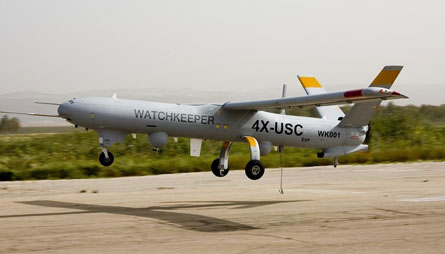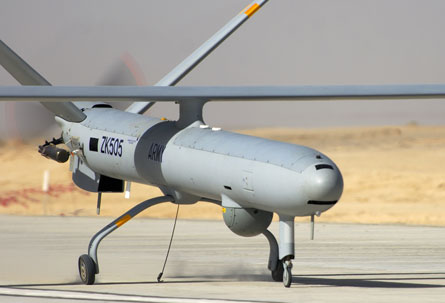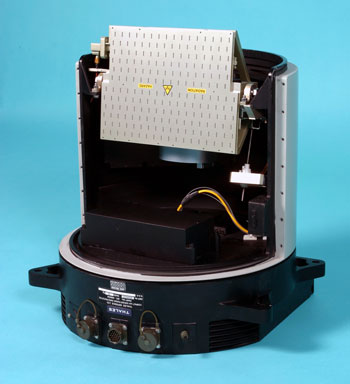The last year has seen a major transformation in the British Army's use of tactical unmanned air vehicles, with the introduction of leased Elbit Systems Hermes 450s, retirement of the BAE Systems Phoenix and first flight of its next-generation Watchkeeper surveillance system.
Now in development ahead of a planned service entry in 2010, the Hermes-derived Watchkeeper 450 (WK450) made its debut flight in northern Israel in mid-April, with its production the result of a collaboration between Elbit and prime contractor Thales UK.
"The external pilot said this was a very robust design and a stable aircraft," following the first fight of around 25min, says Nick Miller, business director, UAV systems for Thales UK's Aerospace Division. The WK450 will soon be flown using its automatic take-off and landing system, a key development from the baseline Hermes 450. Other enhancements include a new wing with de-icing equipment and an improved, UK-sourced engine.
 |
|---|
© Thales UK |
Thales is pursuing a three-phase flight-test programme for the Watchkeeper system. Initial work to prove the enhanced air vehicle design and avionics equipment, including navigation systems supplied by the now-Rockwell Collins-owned Athena Technologies, will continue in Israel through the middle of this year. Israeli-built test aircraft will then be transported to the UK, where they will be joined by UK-built production examples before in-country flight testing starts next year.
To be performed from Thales's facilities at the ParcAberporth UAV centre of excellence in west Wales, which provides access to 6,480km2 (2,500 miles2) of restricted airspace, UK testing will initially be limited to "basic aviation" work, says Miller. This will later be expanded through the addition of further ground system elements, which comprise roughly 70% of the Watchkeeper programme's intelligence, surveillance, target acquisition and reconnaissance capability.
Discussions are also under way with the UK Civil Aviation Authority to approve airspace over the army's Sennybridge training area in Wales and to support collective training on Salisbury Plain, Wiltshire. "There will be overland access at both sites," says Miller.
The WK450 underwent its critical design review in June 2007, and system elements are now in production and test at Elbit/Thales-venture U-TacS' Leicester site in the UK, including ground control stations. Around 100 people are working at the site, which is alongside a Thales factory specialising in the production of land-based electronic warfare equipment and ground radars.
U-TacS is a joint venture, but the Watchkeeper facility also has a UK-only area for sensitive project activities. Production of the WK450 airframe will be in the UK by Lola, with full manufacturing to start in 2009.
A key part of the Watchkeeper system's ISTAR capabilities will be delivered by the UAV's dual payload of Thales I-Master synthetic aperture radar/ground moving target indication sensor (below) and Elop Compass IV electro-optical/infrared device with laser target designator, with the former now in flight test aboard a manned testbed.
|
|
|---|
© Thales UK |
Miller says recent I-Master tests have delivered "very good resolution SAR imagery", while noting that final algorithms have yet to be incorporated. "We are now fine-tuning for the best performance, but it already far exceeds anything else that's out there," he claims. Similar work is continuing in the GMTI mode, and the sensor will soon be removed from its current aircraft for integration with a flight-test UAV.
"Manned I-Master, EO/IR and navigation have been parallel programmes," says Miller. "Now we are doing the integration piece."
Other development activities include looking at on-board processing techniques that would automatically send only the required part of an image via the WK450's datalink, reducing demands on available bandwidth and easing the burden on the army's scarce image analysts and forward air controllers.
Thales is also attempting to fuse data acquired by the EO/IR and SAR/GMTI payloads, with this to enable an operator to perform change detection tasks with a reduced workload. The company is already eyeing potential applications for the I-Master payload with manned fixed-wing aircraft and helicopters. "Watchkeeper is where it's all going to come together," says Miller.
Predicting future export sales of the enhanced UAV system, Elbit is now promoting its own version of the UK product as the Hermes 450B. The firm's marketing agreement with Thales is focused only on the tactical product, but due to its scaleable nature could later be expanded to include its medium-altitude, long-endurance Hermes 900 (below). Expected to fly for the first time later this year, the 900kg (1,980lb) design has many common elements with the current Hermes 450.
 |
|---|
© Elbit Systems |
Growth options for the WK450/Hermes 450B could include increased range or endurance - Elbit has already designed a twin-engined version - plus the integration of different payloads, potentially including hyper-spectral sensors. Further evidence of the burgeoning relationship between the UK and Israeli companies comes in the form of a two-year urgent operational requirement deal with the British Army, under which leased Hermes 450 air vehicles are covering a gap in TUAV services caused by the retirement of the Phoenix.
A contract was awarded to Thales in June 2007, and Israeli-supplied UAVs delivered initial operating capability with the army's 32 Regt Royal Artillery in Afghanistan and southern Iraq the following month.
Operations in both theatres are now described as being "almost continuous", with the interim system having delivered over 4,000 flight hours in Afghanistan and 3,000h in Iraq by earlier this year, with no mishaps (Flight International, 15-21 April). The "ISTAR by the hour" service typically provides around 14-16h of coverage each day using two air vehicles, but Thales says that during one surge of activity the system delivered a continuous 100h of surveillance.
 |
|---|
© Thales UK |
Thales personnel supply maintenance and pre-flight preparation services in conjunction with the Royal Electrical and Mechanical Engineers. Contractor pilots perform take-off and flying to a pre-booked piece of airspace before handing over responsibility to an army commander for the operational phase.
"They might do general surveillance as an initial collector, or track, follow and do battle damage assessment," says Miller. Control is via pre-set waypoints, or by a controller highlighting an area of interest, and each ground control station can run up to three air vehicles. The UAV's EO/IR sensor is also able to automatically track targets of interest, such as land vehicles or an individual person.
"They are learning how to use this, and are seeing what it could give them when a more integrated system is in place," says Miller. "Operators are always asking: what will we be able to do when we have a radar?"
Writing in 32 Regt's Regimental Journal 2008, one staff sergeant notes: "The Hermes 450 is a huge step from the Phoenix. Not just in technology, but capability, endurance and reliability." Conversion work includes full motion video and image interpretation training, plus instruction in airfield operations and systems and theory work. Batteries of 32 Regt also operate Lockheed Martin Desert Hawk III and Mission Technologies Buster mini UAVs.
At the end of the sortie, the contractor pilot again takes control of the Hermes 450 before landing. Operations are now conducted only from runways, but in the future the type will also be able to fly from semi-prepared strips, expanding its mission flexibility.
Hermes 450 operators can relay information to task Royal Air Force strike aircraft in Afghanistan and Iraq, and can send full motion video down to ground troops. However, the WK450 will have a more sophisticated communications architecture, including satellite connectivity, to boost its ability to work in conjunction with other UK and coalition assets.
The UAVs now supporting UK forces have bandwidth allocated through the coalition air tasking order. Miller says there have been no issues with bandwidth limitations. "We have no restrictions on what we can provide, and they are maxing out on the full motion video."
Thales says the use of the Hermes 450 has been widely welcomed by ground forces, due to its ability to provide oversight for vulnerable convoys of land vehicles. "Now they won't go out without UAV over-cover," says Miller.
Source: Flight International
























